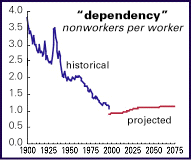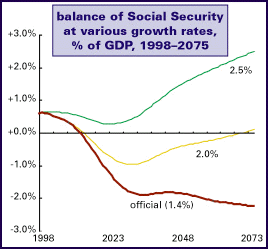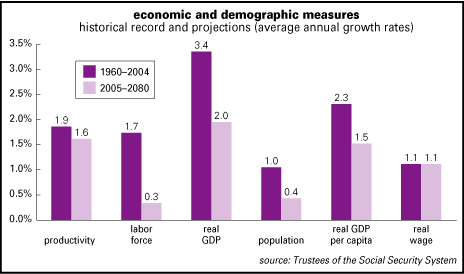|
Henwood is also a contributor to The Nation and other "liberal media" that actually are liberal/leftist (e.g., Pacifica Radio) From Dec. 1994: Of some interest is the news, for example, that the higher the rate of immigration, the sounder the system is, since immigrants (legal or not) tend to be young, and swell the ranks of those paying into the system rather than drawing it down. Immigration, however, won't make or break the Social Security's finances. GDP growth will, since the size of the economy decades hence will determine how much money is available to pay retirees. The bankruptcy scenario is based on an assumption that GDP will grow at a rate seen only in depression decades.
As is common in the work of official seers, the trustees present three sets of forecasts, an official guess, an optimistic one, and a pessimistic one. The official scenario assumes the economy will grow an average of 1.5% a year over the next 75 years half the rate seen in the last 75 (2.9%), and a rate matched only in one decade of the last century, 1910-20's 1.4% rate. The economy grew more quickly even during the 1930s, 1.9% (1930-40). The growth rate for the trustees' optimistic vision, 2.2%, is only slightly bouncier than the 1930s rate. The pessimistic guess is 0.7%, slower than population growth, and a rate so torpid as to guarantee a war of each against all. As the graph shows, the system will go bust only if you assume decades of stagnation. If the economy grows in line with the 197394 average of 2.4%, still slower than the 75-year average of 2.9%, it will run a big surplus.
Either the trustees are deliberately projecting slow growth to feed the pension-cutting mania, or they're expressing a deep pessimism about the U.S. economy's future. Big news, whichever it is.http://www.leftbusinessobserver.com/Pensions.html#SS_bust(the link is to the part of the page that addresses "Is Social Security Really Going Under?", but the part above deals with pension and entitlement "reform", including Peterson's arguments, and is worth a read) From Dec. 1998: Folks on all sides of the debate accept the basic premise, that Social Security faces certain insolvency when the baby boomers retire. Compelling "facts" are trotted out to prove the point: the system will start running a deficit in 2013, and will have spent down all its reserves by 2032. There will be just 1.8 workers for every retiree in 2075, compared with 3.4 today. We could all do better by buying stock in Amazon.com than contracting with Social Security anyway.
Taking these specious points in reverse order: there's no need to say anything about the stock market approach other than to point to the article on p. 5 . The dependency argument needs a bit of attention though. Yes, it's a fact that the population will age, and the number of retirees per worker will rise. Pointing just to those numbers, though, is a selective rendition of history, since the history of capitalism has been to bring an ever-larger share of the population into working for pay. In 1900, there were almost four nonworkers for every paid worker; as almost everyone left the farm and as most women came to draw paychecks, that number fell steadily to just over one today. As the chart shows, the boomer retirement will raise this number a bit, but not by much in the scheme of things. And these, it should be emphasized, are fairly conservative projections. In 2050 there should be a larger share of the population working for pay than in 1950, when mom was at home and the earliest boomers were in kindergarten.

***
The Trustees' growth projections have been trending steadily downward since the early 1980s, so much so that you'd almost think there was an intention behind the trajectory (though the system's actuaries deny any political pressure to emit bearish forecasts to grease the privatization agenda). As is typically the case with official projections, there are three scenarios -- a gloomy one, an optimistic one, and an official, moderate one. In 1981, the Trustees projected a long-term growth rate of 3.1% in their middle scenario and 2.1% in their gloomy one. In 1986, the numbers were 2.5% and 1.4%. And this year, they're 1.4% and 0.6%. The Trustees' optimistic prediction for 1998 -- 2.1% -- matches their most bearish forecast from 1981. Aren't lowered expectations a banished relic of the Carter years?
Rerun the projections with more reasonable -- though still conservative -- projections and the "crisis" largely or fully disappears. If the employment-population ratio for those aged 20-64 remains constant, a third of the projected shortfall for 2020 disappears; if it rises, because the share of women employed approaches that of men, then two-thirds of the projected deficit disappears. As the nearby chart shows, if the economy grows at a modest 2.5% rate, red ink will turn to black. And even if the official bearish projections turn out to be true, the shortfall could be made up easily by subjecting investment income to Social Security taxes, and by eliminating the cap that exempts wage income above a certain maximum ($68,400 in 1998). The reason for sparing such income from Social Security tax is that the program is supposed to be financed solely by labor, with no contribution from capital, capital already being so burdened. The "crisis" of Social Security is a political one, not an economic one.

***
Leading the charge is Wall Street, which would make a fortune out of privatization; no wonder financiers have been discreetly showering money on the privatization campaign. A few quick numbers will explain Wall Street's enthusiasm. Chile's privatized pension system, the enthusiast's favorite model, devotes about 30% of revenues to administrative costs, which means everything from paperwork to brokers' fees to marketing expenses. The U.S. life insurance industry is a bit more efficient, devoting about 10% of premium income to administration, which includes everything from paperwork to profits. Social Security's overhead is under 1%. About $430 billion flowed into the system's coffers this year; 10% of that would be a very pleasing $43 billion, and 30% would yield $130 billion, a windfall even by Wall Street's standards. Higher fees, lower benefits, greater gender inequity, and more risk -- no wonder privatization has to be sold with a cooked-up scare campaign.http://www.leftbusinessobserver.com/AntisocInsec.htmlFrom 2005: Speaking of that productivity revolution, it's nowhere in the projections. Over the very long term, output per worker in the U.S. has grown around 2% a year. Some reputable economists project that the infotech has kicked us up to a higher rate of 2.5% a year, though that seems like a stretch. (Some boosterish business pundits are even pushing an implausible 4% rate.) Lost in their gloomy world, the Social Security Trustees are projecting a 1.6% rate of annual productivity growth through 208020% below the long term average. Those differences might not sound like much, but they really compound over time. At 1.6% a year, productivity in 2080 would be almost 230% of today's levels; at 2.0%, over 340%; at 2.5%, almost 540%. Obviously, the bigger the number, the better the economy will be able to afford its retireesbut the Trustees chose a very small one.
Economic growth isn't only a matter of growth in productivity per worker; it's also determined by the growth in the labor force. And the Trustees project that the growth in the labor force over the next 75 years will be about one-sixth as fast as it was between 1960 and 2004. Some slowdown is likely, since women's entry into paid labor is a trend that may have run much of its course (though just 57% of adult women are working, compared with 72% of men, so that gender gap in employment hasn't closed any more than the pay gap has).
But the Trustees' projection represents a stunning drop from historical experience, and one that can only be partly explained by the 60% slowdown in population growth they foresee. (And one reason for the slowdown in population growth is that they also foresee a sharp dropoff in immigrationimportant, since immigrants tend to be young, making them net contributors to Social Security.) Oddly, they're projecting that the labor force will grow more slowly than the population, even though it's grown nearly twice as fast as population since 1960. Maybe the Trustees are implicitly projecting a breakdown in the American economy's prodigious powers at putting people to workbut if that's the case, it's a big deal, and we should really be talking more explicitly about it.

It's historically and theoretically inconsistent to project a slowdown both in labor force and productivity growth; across time and space, lower population growth has often resulted in higher productivity growth. If labor is plentiful, employers are less keen on squeezing more out of the workforce and are less likely to invest in capital equipment. But this inconsistency is fully consistent with the Trustees' outlook, which is as dark as a goth teen's worldview.
When you put all the Trustees' projections together, productivity and labor force growth, you get a sharp dropoff in projected GDP growthfrom a historical average of 3.4% to an extremely sluggish 2.0%, which is little better than what we saw in the Depression-afflicted 1930s. If the Trustees really expect near-depression rates of growth for the next 75 years, we should be talking explicitly about that as well. Were the economy were to grow at a more normal pace, then the Social Security system could easily pay its projected benefits with no cuts or tax increases.
But no, reply the privatizers; if growth were higher, wage growth would be faster, and therefore benefits (which are keyed to wages) would also rise more quickly, so it'd all be a wash. Someone should tell the Trustees: they're projecting no dropoff in wage growth from now to 2080 despite the sharp drops in productivity and GDP growth. And someone should also tell U.S. employers that higher productivity growth means higher wages: workers have gotten only about 28% of the productivity acceleration since the mid-1990s in the form of higher wages. The rest has gone to profits, which is very nice if you're a CEO or a big stockholder.(if anyone can give some pointers on creating text boxes that work, I'd appreciate a PM) |